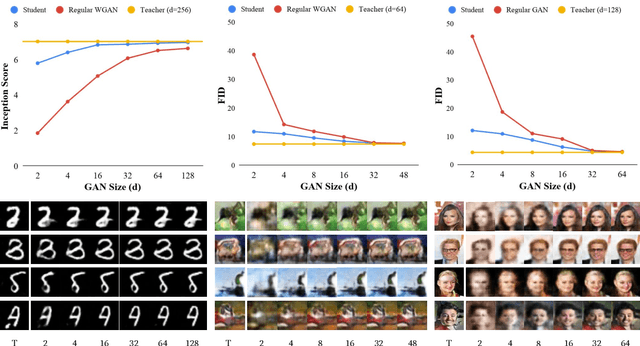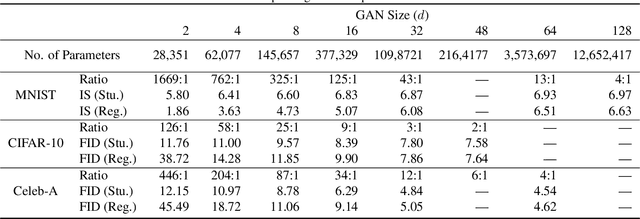Kolten Pearson
Compressing GANs using Knowledge Distillation
Feb 01, 2019



Abstract:Generative Adversarial Networks (GANs) have been used in several machine learning tasks such as domain transfer, super resolution, and synthetic data generation. State-of-the-art GANs often use tens of millions of parameters, making them expensive to deploy for applications in low SWAP (size, weight, and power) hardware, such as mobile devices, and for applications with real time capabilities. There has been no work found to reduce the number of parameters used in GANs. Therefore, we propose a method to compress GANs using knowledge distillation techniques, in which a smaller "student" GAN learns to mimic a larger "teacher" GAN. We show that the distillation methods used on MNIST, CIFAR-10, and Celeb-A datasets can compress teacher GANs at ratios of 1669:1, 58:1, and 87:1, respectively, while retaining the quality of the generated image. From our experiments, we observe a qualitative limit for GAN's compression. Moreover, we observe that, with a fixed parameter budget, compressed GANs outperform GANs trained using standard training methods. We conjecture that this is partially owing to the optimization landscape of over-parameterized GANs which allows efficient training using alternating gradient descent. Thus, training an over-parameterized GAN followed by our proposed compression scheme provides a high quality generative model with a small number of parameters.
Neural Network Interpretation via Fine Grained Textual Summarization
Sep 06, 2018



Abstract:Current visualization based network interpretation methodssuffer from lacking semantic-level information. In this paper, we introduce the novel task of interpreting classification models using fine grained textual summarization. Along with the label prediction, the network will generate a sentence explaining its decision. Constructing a fully annotated dataset of filter|text pairs is unrealistic because of image to filter response function complexity. We instead propose a weakly-supervised learning algorithm leveraging off-the-shelf image caption annotations. Central to our algorithm is the filter-level attribute probability density function (p.d.f.), learned as a conditional probability through Bayesian inference with the input image and its feature map as latent variables. We show our algorithm faithfully reflects the features learned by the model using rigorous applications like attribute based image retrieval and unsupervised text grounding. We further show that the textual summarization process can help in understanding network failure patterns and can provide clues for further improvements.
 Add to Chrome
Add to Chrome Add to Firefox
Add to Firefox Add to Edge
Add to Edge